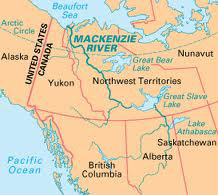As the House of Representatives makes their symbolic vote in favor of the Keystone tar sands pipeline today, Canada is looking for other avenues to push tar sands out if the US ends up saying no.
The government’s idea of pushing a pipeline west through Canada to the Pacific coast – the Northern Gateway – is getting the same pushback from native tribes as is the Keystone pipeline here.
People in Vermont, New Hampshire and Maine aren’t excited about using their 62-year old crude oil pipeline for tar sands oil either.
So where else can they go?
Talks are in progress to go straight up to the Arctic, where tar sands would travel through the Mackenzie River Valley to a new deep-water port on the Beaufort Sea, part of the Arctic Ocean. Alberta province has hired a consulting firm to evaluate the project.

It’s easy to imagine the problems of a pipeline filled with hot tar sands crude on pristine tundra that’s largely permafrost. The frozen soil would thaw and turn into mud, releasing huge amounts of methane and basically sinking the pipeline. The pipeline could even buckle, says Pipelines International.
Enbridge, responsible for the Kalamazoo tar sands spill, wants to increase the volume of tar sands through the existing pipeline that goes to Wisconsin. It would increase the volume to 880,000 barrels a day – more than what Keystone would carry. That oil would then flow to Midwest and Gulf Coast markets via other existing pipelines that were not constructed to carry tar sands (same situation as the Arkansas spill).
"We’re very concerned this has flown under the public’s radar. "The public doesn’t seem to have the same sort
of attention for pipeline expansions as they do for pipeline construction. But we’re talking about a lot of crude," Peter LaFontaine, an energy policy advocate for the National Wildlife Federation told Bloomberg.
Enbridge’s proposal is "just as bad as Keystone because the expansion carries the additional risk of polluting the Great Lakes. This stuff is going to end up in Lake Superior," Eddie Scher of the Sierra Club, told Bloomberg.
The State Department just close the comment period on this May 13.
Essentially, tar sands companies are looking in every direction to export from Canada because rising production is already overwhelming existing pipelines and depressing prices. If they aren’t stopped, their goal is to more than double production to 3.38 million barrels a day by 2021, according to the Canadian Association of Petroleum Producers.
Meanwhile, lobbying the US has reached a fevered pitch, almost all of in favor of the Keystone pipeline. 50 groups are exerting pressure, making it a "full-employment program for K Street," Bill Allison of Washington watchdog Sunlight Foundation, told Bloomberg.
Organizations lobbying include the American Petroleum Institute and all the oil companies, construction equipment manufacturers such as Deere & Co., labor unions, the government of Canada – all in favor – and the few environmental groups that have some money such as the League of Conservation Voters and Greenpeace- who are against it.

